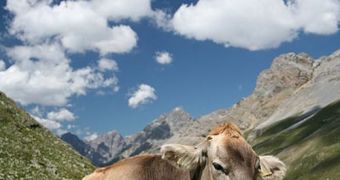According to the conclusions of a new international study, it would appear that authorities worldwide are currently placing very little emphasis on mitigating the amount of greenhouse gases released by livestock around the world. Most often, cattle and other animals produce methane.
This greenhouse gas is around 300 times more potent than carbon dioxide (CO2). Though its concentrations are nowhere near as high in the atmosphere as those of CO2, its presence is constantly getting stronger, researchers in the United States, Austria, Scotland and Australia reveal.
The new study was conducted by William Ripple, who is a professor with the College of Forestry at the Oregon State University (OSU). Details of the work were published in the December 20 issue of the top scientific journal Nature Climate Change.
Data and statistics used in this study were collected from the UN Food and Agricultural Organization (FAO), the United Nations Framework Convention on Climate Change (UNFCCC), as well as from a number of recent studies published in peer-reviewed journals, EurekAlert reports.
Scientists in the group say that current global warming mitigation protocols are largely focused on cutting carbon dioxide emissions, while not much attention is paid to methane and other potent greenhouse gases. However, these emissions will have to be cut as well to prevent climate change.
Most commonly, livestock produces methane and nitrous oxide in plenty. Cows and other large grazing animals are the primary non-anthropogenic source of greenhouse gases, accounting for around a third of GHG emissions that are not carbon dioxide.
“Because the Earth's climate may be near a tipping point to major climate change, multiple approaches are needed for mitigation. We clearly need to reduce the burning of fossil fuels to cut CO2 emissions. But that addresses only part of the problem,” Ripple says.
“We also need to reduce non-CO2 greenhouse gases to lessen the likelihood of us crossing this climatic threshold,” the team leader adds. This year, a long-term study demonstrated that the amount of methane being produced by livestock in the United States is much higher than originally estimated.
“Reducing demand for ruminant products could help to achieve substantial greenhouse gas reductions in the near-term, but implementation of demand changes represent a considerable political challenge,” concludes study coauthor Helmut Haberl, who holds an appointment with the Institute of Social Ecology in Austria.

 14 DAY TRIAL //
14 DAY TRIAL //